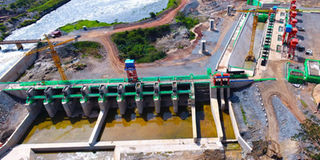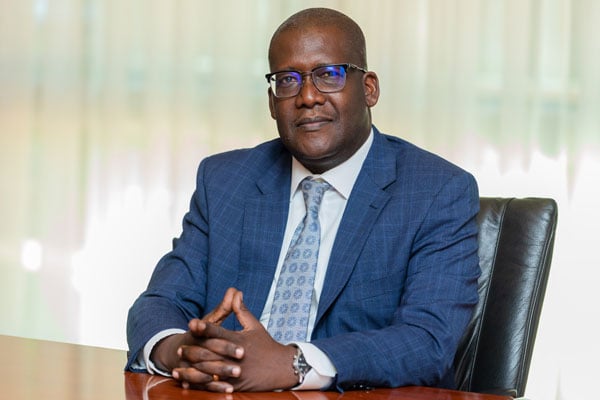Fix tax leaks to minimise borrowing for infrastructure

An aerial view of Karuma Dam under construction. Government is borrowing heavily to finance infrastructure projects in Uganda. FILE PHOTO
What you need to know:
- To reduce the infrastructure financing burden, policymakers will have to attract and retain both new and old domestic sources of finance and develop innovative mechanisms such as remittances and savings from curtailing illicit financial flows.
Uganda must watch her appetite for borrowing, before she entangles herself into debts whose consequences according to the continent’s economists, policy analysts and researchers, will not only be costly but also damaging to the economy.
Most of the external borrowing in Uganda’s case is geared towards infrastructure development. According to the AfDB’s African Economic Outlook 2018, the annual infrastructure deficit in Africa is currently estimated at $108 billion.
The same report also notes that for an African governments like Uganda to deliver quality infrastructure, it will need over $130-170 billion a year. This explains the rush for external borrowing to finance national, regional and in some instances continental infrastructure in energy, transport, trade and natural resources.
Debt
So governments across the continent, including Uganda, are either struggling with debt or experiencing debt distress. According to the recent Budget Speech, the stock of Government debt rose to Shs42.7 trillion – equivalent to $11.5 billion – as at end-December 2018 from Shs37.2 trillion – equivalent to $10.2 billion – within one financial year. Of that, external debt constitutes is 66.5 per cent of the total debt amounting to Shs28.4trillion -about $7.7 billion, with the domestic debt constituting the balance.
Spending on infrastructure has not only increased public debt but also heavy infrastructural investments despite warnings from economists.
Dr Fred Muhumuza, an Economics lecturer at Makerere School of Economics, says this trend is incapacitating growth of some other key economic sectors like agriculture (and value addition), manufacturing, trade and investment.
During his presentation last week in Entebbe at the Pan-African Conference on Financing for Health and Roads Infrastructure in Africa, senior policy analyst at AFRODAD, Mr Tirivangani Mutazu while presenting a paper on ‘African Perspectives on Financing Infrastructural projects – Implications for using debt resources,’ said borrowing for financing infrastructural projects is not bad at all. But he argued it shouldn’t be at the scale that is currently happening. It can be scaled down.
He said: “There is nothing like over investing in infrastructure. But African governments must explore alternative sources of funding, such as the potential financing from pension funds, insurance companies, sovereign wealth funds. They should mobilise domestic resources for energy projects other than relying on donor funds.”
He said curtailing illicit financial flows requires institutional capacity-building to enforce and once done, so much will be accrued that should be invested in infrastructure projects. This should be hand in hand with fighting corruption in government revenues.
Uganda and its peers should conduct a thorough investigation before any project is implemented and results of the project evaluation and studies should be made public.
Fix tax loopholes
Another possible way of reducing borrowing for mega infrastructural projects in Uganda, according to Mr Mutazu, is by closing tax leakages, mostly taken advantage of by some multinational companies which are determined to employ all sort of tricks to paying their fair share of taxes.
Already, Africa is estimated to be losing more than $50billion (about Shs183 trillion) in illicit financial flows every year, according to the High Level Panel on Illicit Financial Flows from Africa report.
Uganda alone, is projected to be losing in excess of Shs2 trillion annually, which is a conservative estimate according to experts and a section of civil society organisations. It is further feared that once commercial production of the country’s oil and gas begins, the situation could get worse.
Infrastructure financing
To reduce infrastructure financing burden, policymakers, according to Mr Mutazu, will increasingly have to attract and retain both new and old domestic sources of finance and develop innovative mechanisms such as remittances, savings from the curtailment of illicit financial flows, diaspora funds, better negotiated mineral contracts and the expansion of national and continent’s (Africa’s) fiscal space.
He said: “These innovative sources of finance if properly leveraged, would considerably reduce governments’ dependence on external resources and provide the requisite resources for the implementation of regional and global development agenda.”
For Uganda’s case, trade misinvoicing is the most significant area of illicit financial flows. This can be estimated using publicly available data which indicates that from 2006 to 2015, the potential trade misinvoicing amounted to roughly 18 per cent of total Ugandan trade over the same ten-year period.
Analysts like Mr Mutazu plus experts on debt management at Uganda Debt Network (UDN) believe that once the tax leakages are fixed, Uganda wouldn’t worry about exclusively financing infrastructure projects with expensive borrowed funds. This is because there has been a shift from official development assistance being the core to finance development in African countries like Uganda to a framework largely depending on external debt and therefore placing greater emphasis on the mobilisation of domestic resources.
Resource requirements for Uganda and Africa’s structural transformation are huge, with traditional sources of development finance such as oreign Direct Investment and Official Development Assistance dwindling becoming unreliable.




